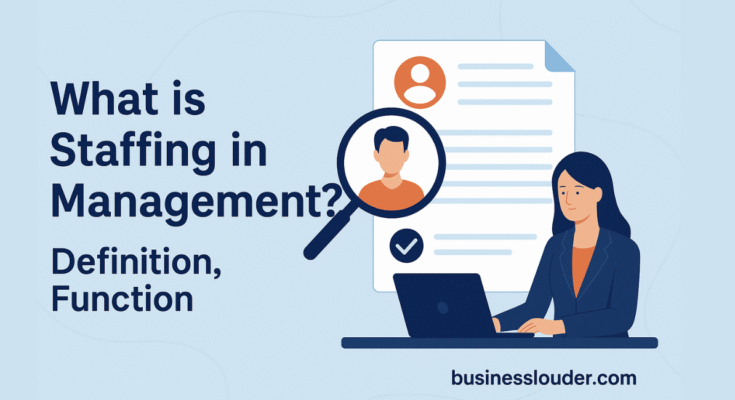What is Staffing in Management?- Human resource is one of the principal assets for an organization. In every business organization, resources like – money, machine, material, etc. can be utilized effectively and efficiently only by the positive efforts of its human resources.
Here in this blog post we will see what is staffing in management and what is its definition, objectives, functions, importance, process. Let’s first understand what is staffing in management.
What is Staffing?
Definition of Staffing: It is the process of hiring and maintaining eligible and competent candidates to fill the specific vacant positions from the top level to the subordinate levels in the management. In management, staffing is an operation of recruiting employees by evaluating their knowledge, skills, and then offering them specific job roles accordingly.
What is Staffing in Management?
Definition of Staffing in Management: According to Koontz and O. Donnell, Staffing is that managerial function which involves manning the organizational structure with people and their effective selection, appraisal, and development of personnel in order to fill the roles designed into the structure.
Objectives of Staffing
1. Talent Acquisition
One of the major objectives of the staffing processs is to hire the best talent for the particular role in the organization. While staffing, the organization can make a rough map about the type of employees that will be suitable for the job to enhance talent acquisition.
This helps to know the organization’s objective, and improves productivity of the employees in the organization as it will require competent and efficient employees to achieve its objectives.
2. Recruitment and Selection
Staffing ensures the continuity and growth of an organization by recruitment and selection. This process also promotes the utilization of human resources in an efficient manner.
3. Competitive Advantage
When business organizations start to recruit skilled and qualified candidates onto the team, the team becomes more efficient to have a competitive advantage in the market.
Staffing focuses on the recruitment, development, and training of human resources for the different roles in the organization. Thereby, contributing to improved productivity in the management.
4. Training and Development
Training and development is an essential part of the staffing process to develop and grow the skills of new employees and enhance the organization’s productivity.
The workers are developed by giving real-time projects as an examination not only to analyze the performance, but also to find areas for improvement.
5. Job Satisfaction
When an employee specializes in their job role, it increases their productivity and enhances organizational growth. Without proper human resources for a particular role, the organization does not perform well. Employee morale is vital for any type of management to maintain a harmonious workplace culture.
Functions of Staffing
1. Continuous Function
Staffing is a continuous process as it continues throughout the life of an organization. Staffing function needs to be performed continuously which is equally important for a new as well as a well-established organization. Staffing is necessary to meet the growing needs of an organization.
2. Human Skills
Staffing function is concerned with different types of training and development of human resources. If the staffing function is executed properly, then the human relations in the organization will be cordial and mutually performed in a harmonious manner.
3. Responsibility of Manager
Staffing is the basic function of management. It involves the manager to be continuously engaged in performing the staffing function. They are actively associated with the recruitment, training, and appraisal of his subordinates.
These activities are performed by the chief executive, foremen, and departmental managers in relation to their subordinates.
4. People-Centered
Staffing can be broadly viewed as a people-centered function.Therefore, it is relevant for all types of organization.
Importance of Staffing
1. Managing Effective and Competent Personnel
Staffing involves workforce planning, recruitment, appointment, and proper arrangement of people through proper selection process and placement of the right person for the right job.
It includes training, development, grievance handling, compensation, etc. Staffing helps with obtaining competent staff for various jobs and helps maintain the right size of the employees.
2. Effective utilization of Technology and Other Resources
Staffing ensures effective utilization of physical resources such as money, materials, machines, and also of latest technology, capital, material, etc. This effective utilization of resources contributes to minimizing wastage, which ultimately helps in minimizing the total cost of output or service.
3. Optimum Utilization of Human Resources
Since a huge amount is spent on recruitment, training, and development of employees, to get the optimum output, staffing functions should be performed in an efficient manner. Staffing process should ensure optimum use of human resources by avoiding overstaffing. It should prevent underutilization of personnel and high abor cost.
The staffing process also helps in avoiding disruption of work by indicating the shortage of personnel in advance.
4. Building Higher Job Satisfaction and Morale
Proper staffing improves not only the job satisfaction but also the morale of employees. The right type of working environment and culture should be created for the employees to contribute to the achievement of the organizational objectives. When a person is hired for the right kind of job, it gives him/her the utmost satisfaction and a sense of belonging.
Therefore, by performing the staffing function efficiently and effectively, the management encourages a better working environment in the organization. This in turn, makes employees more effective in their jobs and improves their overall performance.
5. Helps to Solve Problems
Staffing also helps in solving the human resource problems of the organization. If the staff or employees are professional and competent, they will understand the organizational situation and help in solving human resource problems.
Process of Staffing
The process of Staffing is the first and major step in human resource management. Let’s now see what are the different steps that make up the Staffing Process.
1. Assessing the Manpower Requirements
The very first step of staffing is to evaluate the manpower requirement of an organization that matches the job and positions available in the organization. It helps in determining the qualifications and skills required for a specific job in the organization.
2. Recruitment of Employees
Once the requirement is evaluated, the next step involves actively searching for prospective persons that are eligible for the job and also inviting applicants to apply for the positions.
In this process, the employer advertises about the vacancies in the organization through various media, which makes it easy for the applicants to know about the job vacancy and the required skills.
3. Selection of Employees:
Selection process helps in screening the employees and identifying the deserving candidate for a specified job. The main aim of selection is to identify the right employee for the right type of job.
4. Orientation and Placement
Once the right candidate is selected, the organization makes him/her familiar with the working units and environments through various orientation programs. Then, placement is done by putting the right candidate at the right place which helps in proper functioning of the organization.
5. Training and Development
After placement, the next step involves training and development of employees. Training is an integral part of the staffing process and shouldn’t be skipped in any way; it helps employees in developing their skills and knowledge.
6. Remuneration to Employees
Remuneration is the compensation given to employees in monetary terms in exchange for their work for the organization. It is given in accordance to the work done by the employees.
7. Performance Evaluation
Performance evaluation is done to assess the attitude, behavior, and performance of an employee. This step of staffing helps the management in determining the success of the whole recruitment process, and gives them a clear picture of the success rate of the entire recruitment procedure.
This step includes vital elements like appraisal, promotion, and transfer. The performance of the employee is assessed in comparison to other employees and also to his/her previous performance. Based on these criteria, the employee might get a hike on his pay or a promotion. Sometimes, employees are transferred to another branch of the company or given certain benefits.
The Closing Lines
We hope you can be understood what is staffing in management from this article, ‘Staffing’ is quite a significant element of management. It is very important for each and every person to get the right position in a business organization so that they can be given the right job, according to their aptitude, ability, talent, and specializations. A management can achieve its objectives and goals only when it has the right people in the right positions.



